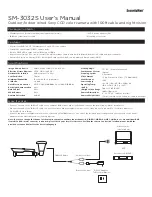
SPA
30
The Interface Solution Experts
Site-Programmable RTD &
Thermocouple Limit Alarm Trips
LEDs
There are at least three, and as many as six LEDs
on the front panel of the SPA. Each is labeled, and
provides a quick reference for input condition during
normal unit operations.
• READY
This LED shows green during normal
operation. Green indicates that the SPA has run its
startup diagnostic and that all internal circuitry is
functioning properly.
The LED goes out if internal errors occur.
• INPUT
This LED shows green during normal
operation. Green indicates that an input sensor or
sensors has/have been connected, and that they
are functioning properly.
The LED turns red if there is a problem with the
sensor inputs. On TPRG SPAs, sensor problems
are also accompanied by a message on the LCD
diagnosing the specific problem. Sensor failures
and individual wire breaks are all called out by the
TPRG SPA’s Total Sensor Diagnostics.
• TRIP #
These LEDs, one per installed relay, show
green when the connected input is in a non-alarm
condition relative to the trip point setting. A red
LED indicates alarm.
NOTE:
The state of the SPA relays in alarm or non-
alarm is determined by the failsafe/non-failsafe
setting of the unit’s internal DIP switches
(see Figure 3, earlier in this manual). Do not
confuse the state of the LED with the state of
its associated relay.
Failsafe relays are ON (energized) when input
is in a non-alarm condition (green LED), OFF
(de-energized) in alarm (red LED).
Non-failsafe relays are ON (energized) when
input is in an alarm condition (red LED), OFF
(de-energized) in non-alarm (green LED).
This design scheme means that the LEDs
associated with relays will always show red when the
corresponding input is in an alarm condition, green in
non-alarm.
Manual Reset
There are two connections labeled “MR + -” on the
SPA top terminal block. These terminals work in
conjunction with the latching/non-latching alarm
function.
When an SPA is configured with latching alarms (refer
to the description of the “CONF ALRM” menu, earlier
in this manual), an alarm condition will not “clear”,
that is, the relay will not change state, until the input
returns to a non-alarm state AND these manual reset
terminals are shorted.
Shorting the MR terminals “clears” all alarms.



































